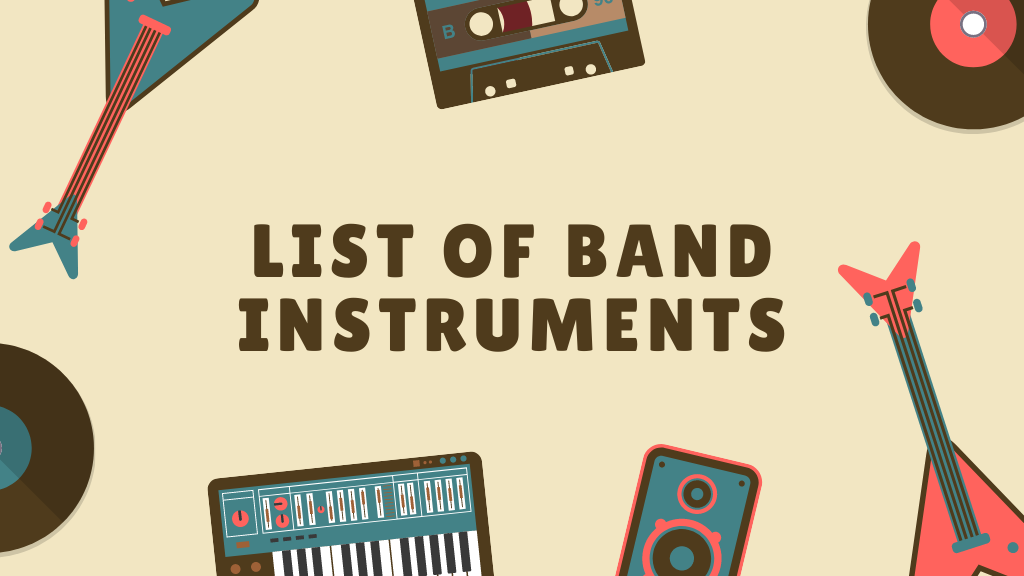Music has always been a universal language, and band music holds a unique place in history and culture. Whether in schools, orchestras, marching groups, or concert ensembles, band instruments bring together different tones and textures that create unforgettable performances. If you are new to music or looking to deepen your understanding, exploring a list of band instruments can give you valuable insights into how each instrument contributes to the sound of a band. From woodwinds and brass to percussion, every instrument plays a distinct role that adds richness and depth to the overall harmony.
Band music has evolved for centuries, with instruments continuously adapting to fit new styles and genres. In modern times, the variety of instruments allows performers to explore classical pieces, jazz standards, contemporary music, and even cinematic scores. Understanding each instrument’s role helps musicians collaborate better and helps listeners appreciate the delicate balance that makes bands so captivating.
Understanding Band Instruments
Band instruments are typically divided into families: woodwinds, brass, and percussion. Each family has its own unique characteristics, and within them, every instrument offers a specific voice that blends or contrasts with others. Students learning music often start with these instruments in school bands, while professionals use them to perform in concerts, orchestras, and even military settings.
The relationship between these families is essential to the structure of band music. Woodwinds provide agility and melodic color, brass adds richness and power, while percussion gives rhythm and drama. This careful balance ensures that performances are not only harmonious but also dynamic and exciting.
List of Band Instruments
Flute
The flute is a popular choice among beginners and professionals alike. Made of metal or silver, it produces sound when air is blown across the mouthpiece. Its bright, clear tone makes it a key player in both concert and marching bands. Flutes often carry the melody and can perform rapid passages with ease, giving them a versatile role in band performances. In addition to traditional flutes, there are also piccolo flutes, which provide even higher-pitched sounds that cut through large ensembles with brilliance.
Clarinet
The clarinet is a single-reed instrument known for its warm, rich sound. It has a wide range, from deep, mellow tones to bright, piercing notes. The clarinet’s adaptability makes it essential in school bands, jazz ensembles, and orchestras. It often bridges the gap between higher-pitched woodwinds and lower brass, offering balance to the group’s overall sound. Advanced clarinet players can also play variations such as the bass clarinet, which provides deeper tones that strengthen the lower register of the woodwind family.
Oboe
The oboe stands out with its double-reed design and distinctive nasal tone. While not as common in beginner bands, it is a vital instrument in advanced ensembles. The oboe often plays expressive melodies that require precise control, and its tuning note is used to set pitch for the entire band. Its unique voice brings a haunting, emotional quality to musical pieces, and in concert bands, it often takes on melodic lines that require both accuracy and sensitivity.
Bassoon
The bassoon is the largest standard woodwind instrument, known for its deep and resonant sound. With a wide range, it can provide bass lines as well as lyrical melodies. The bassoon adds depth and complexity to the woodwind section, often working closely with lower brass to create a strong foundation in band music. Despite its size and complexity, skilled bassoon players can also bring out a surprisingly playful, agile tone in faster passages, which adds character to musical performances.
Saxophone
The saxophone, though technically a woodwind due to its reed, is often associated with jazz. In bands, it bridges the woodwind and brass sections, offering a smooth, powerful tone. Available in multiple types alto, tenor, baritone the saxophone is versatile and frequently used in both melodic and harmonic roles. Its expressive sound makes it a favorite for solo performances. The saxophone’s ability to shift from soft, mellow passages to bold, commanding tones gives it a unique edge in both classical and contemporary band settings.
Brass Instruments
Trumpet
The trumpet is one of the most recognizable band instruments, celebrated for its bright, bold sound. It plays a leading role in melodies and fanfares, cutting through the ensemble with clarity. Its versatility allows it to be used in classical, jazz, and marching music. Trumpet players require strong breath support and precision to achieve its dynamic range. In a band setting, the trumpet is often used for dramatic flourishes, creating moments of excitement that elevate the performance.
Trombone
Unique for its slide mechanism, the trombone produces a rich, brassy tone that can shift smoothly between notes. It is often used for harmonies, counter-melodies, and powerful bass lines. In bands, the trombone balances the brilliance of the trumpet and the depth of the tuba, making it an indispensable instrument in ensembles. Its versatility also makes it popular in jazz groups, where its glissando technique (sliding between notes) adds expressive flair.
French Horn
The French horn is known for its round, mellow tone and wide range. Its coiled design and hand-stopping technique allow musicians to create a variety of timbres. Often playing harmonies and blending with both woodwinds and brass, the French horn adds warmth and depth to the ensemble. Its expressive sound makes it a staple in orchestral and band settings. In concert pieces, French horns frequently transition between background harmonies and bold, lyrical solos, making them one of the most versatile instruments in the brass family.
Tuba
The tuba is the largest brass instrument, providing the foundational bass in band music. Its deep, resonant sound anchors the harmony, supporting the entire ensemble. Despite its size, the tuba can also perform lyrical passages with surprising agility. In marching bands, the sousaphones related version is often used for mobility. Without the tuba, bands would lack the grounding depth that gives their music weight and power.
Euphonium
The euphonium is often described as a smaller tuba with a sweeter, more lyrical tone. Its sound is rich and warm, making it ideal for solo passages and harmonies alike. Euphoniums are highly valued in concert bands and brass ensembles for their ability to blend with other instruments while maintaining a distinct presence. It is frequently chosen by players who want to perform both melodic lines and harmonic support, offering flexibility that enhances the richness of a band’s sound.
Percussion Instruments
Snare Drum
The snare drum is the backbone of marching and concert bands. Known for its sharp, crisp sound, it keeps time and provides rhythmic energy. With its distinctive snap, the snare drum drives the tempo and adds dramatic flair to musical performances. Its importance cannot be overstated, as it often serves as the heartbeat of the band, ensuring every section stays in sync.
Bass Drum
The bass drum delivers the lowest and most powerful beats in the percussion section. It emphasizes rhythm and creates impact during crescendos and climaxes. Its deep resonance supports the band’s overall rhythm and adds dramatic depth to performances. Marching bands often feature the bass drum as a visual and auditory centerpiece, marking the pulse that guides the entire ensemble.
Cymbals
Cymbals add brilliance and drama to band music. Whether crashed together for a powerful accent or played softly for shimmering effects, cymbals provide dynamic contrast. Their versatility allows them to contribute in both subtle and explosive ways, enhancing the overall sound of the ensemble. Cymbal players must master timing and control, as a single well-placed crash can transform the mood of a performance.
Timpani
The timpani, or kettle drums, are pitched percussion instruments tuned to specific notes. They provide both rhythm and harmony, blending seamlessly with other sections of the band. Timpani often highlights dramatic moments in music and requires precise technique to play effectively. They are unique among percussion instruments for their melodic potential, which sets them apart from purely rhythmic counterparts.
Xylophone
The xylophone consists of wooden bars struck with mallets, producing a bright, percussive tone. Its clear, ringing notes often carry melodies or add color to the music. The xylophone adds sparkle and variety to the percussion section, making it a vital instrument in concert settings. In addition to traditional wooden xylophones, modern bands also make use of marimbas and vibraphones, which extend the range and tonal possibilities of the percussion family.
Importance of Each Instrument in a Band
Each instrument has a specific role, whether it is carrying the melody, providing harmony, or supporting rhythm. Woodwinds add color and agility, brass deliver power and richness, while percussion drives the beat and enhances dramatic moments. Together, they form a balanced and cohesive unit capable of performing a wide range of musical styles.
A band without its full range of instruments feels incomplete, much like a puzzle missing key pieces. Every instrument, regardless of size or prominence, has a purpose in shaping the overall sound. This collaboration between families ensures that performances resonate with audiences, whether they are in small auditoriums, open fields, or grand concert halls.
FAQs
What are the main families of band instruments?
Band instruments are generally grouped into three families: woodwinds, brass, and percussion. Each family contributes a different tone and role to the ensemble.
Which band instrument is best for beginners?
The flute, clarinet, trumpet, and snare drum are popular beginner instruments because they are widely taught in schools and offer manageable learning curves.
How many instruments are typically in a concert band?
A concert band usually features between 40 to 80 musicians, depending on the size of the ensemble and the type of music being performed.
What is the difference between a concert band and a marching band?
While both feature similar instruments, a concert band performs seated in formal settings, focusing on a wide range of music. A marching band performs while moving, often at sporting events or parades, emphasizing rhythm and visual presentation.
Why is learning about band instruments important for students?
Understanding different band instruments helps students choose one that matches their interests and abilities. It also provides insight into how each instrument contributes to the sound of the group.
Conclusion
Learning about the list of band instruments gives musicians and music lovers a deeper appreciation of how bands work. Each instrument, from the delicate flute to the powerful tuba, adds a unique voice that shapes the ensemble’s sound. Whether you are a beginner exploring options or an experienced musician, knowing the role of each instrument can help you understand the beauty and complexity of band music. Together, these instruments create harmony, rhythm, and emotion, making band performances an unforgettable experience.





